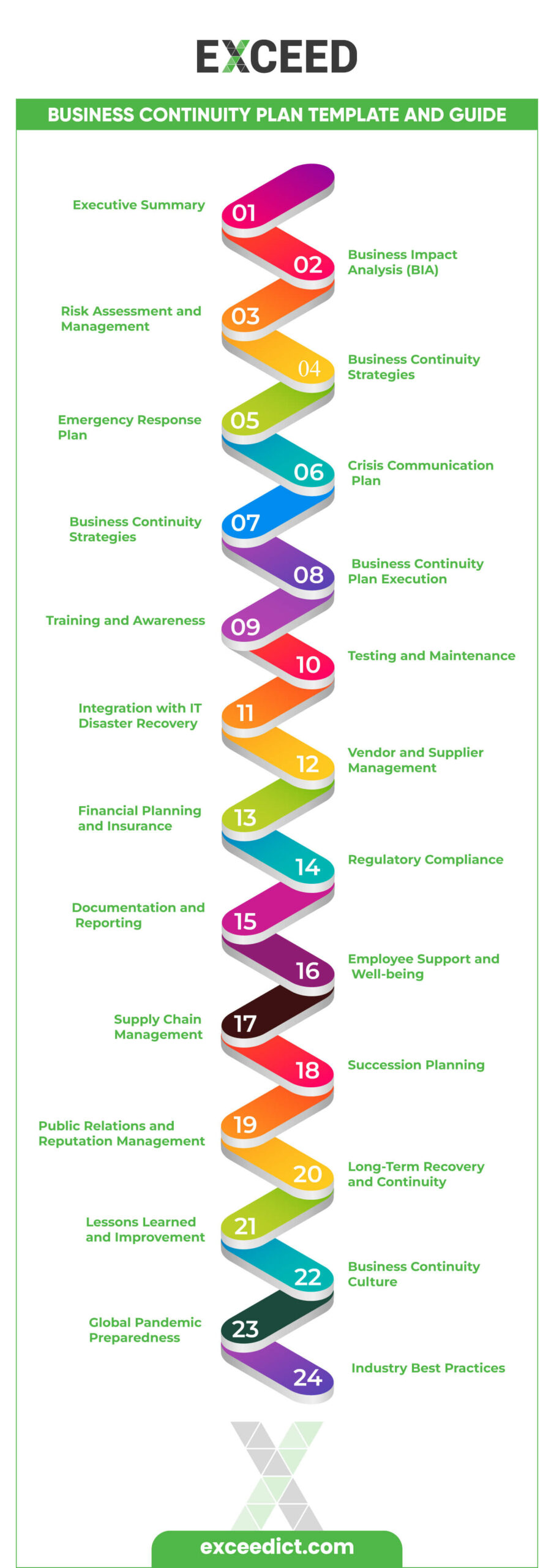
Business Continuity Plan Template and Guide To Ensure Seamless Operations in Times of Crisis
 In today’s unpredictable business landscape, organisations must be prepared to face unexpected disruptions that can jeopardise their continuity.
In today’s unpredictable business landscape, organisations must be prepared to face unexpected disruptions that can jeopardise their continuity.
Whether it’s a natural disaster, cyberattack, or a global pandemic, having a well-defined Business Continuity Plan (BCP) is essential to ensure the smooth functioning of operations during challenging times.
This article provides a comprehensive guide and template for creating a robust Business Continuity Plan to help businesses thrive even in the face of adversity.
Business Continuity Plan Template and Guide
A well-structured Business Continuity Plan acts as a roadmap for organisations to navigate through disruptions, maintain essential functions, and minimise downtime. Let’s delve into the key elements that constitute an effective Business Continuity Plan.
 1. Executive Summary
1. Executive Summary
The Executive Summary provides a concise overview of the entire Business Continuity Plan. It outlines the purpose, objectives, scope, and limitations of the plan. Additionally, it identifies key stakeholders involved in executing the BCP, ensuring everyone is aware of their roles during emergencies.
2. Business Impact Analysis (BIA)
A crucial step in creating a BCP is conducting a Business Impact Analysis (BIA). This involves identifying critical processes and functions that are vital for the organisation’s survival. By assessing the impact of potential disruptions on these processes, businesses can prioritise recovery efforts effectively. The BIA also helps in determining the Recovery Time Objectives (RTO) and Recovery Point Objectives (RPO) for each critical function.
3. Risk Assessment and Management
Conducting a thorough risk assessment is essential to identify potential threats and vulnerabilities that could lead to disruptions. Analysing the probability and impact of each risk enables businesses to develop mitigation strategies to minimise the likelihood of occurrence or mitigate the consequences.
4. Business Continuity Strategies
This section focuses on developing continuity strategies to ensure that critical functions can continue operating during a crisis. It involves allocating necessary resources, establishing alternate sites if required, and implementing redundancy measures to enhance resilience.
5. Emergency Response Plan
An Emergency Response Plan outlines the actions to be taken immediately after a disruptive event occurs. It involves forming emergency response teams, defining roles and responsibilities, and coordinating with external agencies, such as emergency services and law enforcement.
6. Crisis Communication Plan
Effective communication is crucial during a crisis to keep employees, stakeholders, and the public informed. A Crisis Communication Plan establishes communication protocols, both internal and external, and addresses media management to ensure accurate and timely dissemination of information.
7. Business Continuity Plan Activation
This section focuses on the triggers that activate the Business Continuity Plan. It defines the circumstances under which the plan should be put into action. Additionally, it involves activating the Emergency Operations Centre (EOC) and mobilising resources to execute the BCP.
8. Business Continuity Plan Execution
Once the BCP is activated, this section deals with the implementation of recovery strategies. Monitoring progress and effectiveness are vital to adapt to evolving situations. Flexibility and adaptability are essential traits during execution.
9. Training and Awareness
Employees must be well-informed about the BCP and their roles during a crisis. Conducting regular BCP training and raising awareness among employees helps ensure they are prepared to respond effectively.
10. Testing and Maintenance
Regular testing of the BCP is critical to verify its effectiveness and identify any shortcomings. Various types of testing, such as tabletop exercises and simulations, should be conducted. Moreover, updating the plan based on test results and changing circumstances is necessary to keep the BCP relevant.
11. Integration with IT Disaster Recovery
A comprehensive BCP must align with the IT Disaster Recovery Plan to ensure seamless restoration of IT services. Coordinating IT resilience efforts and establishing data backup and restoration processes are essential.
12. Vendor and Supplier Management
Collaborating with vendors and suppliers who also have robust BCPs is crucial for maintaining supply chain continuity. Developing contingency agreements with critical vendors ensures a coordinated response to disruptions.
13. Financial Planning and Insurance
Adequate budgeting for BCP implementation and reviewing insurance coverage helps organisations mitigate financial risks during a crisis.
14. Regulatory Compliance
Complying with legal and industry standards is imperative for businesses. BCP audit and validation processes ensure adherence to regulations, while reporting requirements provide transparency.
15. Documentation and Reporting
Maintaining comprehensive documentation of incidents and responses is vital for post-incident analysis. It helps identify areas for improvement and supports decision-making during future crises.
16. Employee Support and Well-being
During a crisis, employees’ well-being and mental health are essential considerations. Establishing employee assistance programs and offering psychological support fosters resilience in the workforce.
17. Supply Chain Management
Assessing supply chain vulnerabilities and building redundancy in critical components ensures uninterrupted supply during disruptions. Collaborative planning with suppliers enhances resilience.
18. Succession Planning
Identifying key personnel and skills is vital for continuity. Developing succession plans ensures the smooth transfer of responsibilities during employee absences.
19. Public Relations and Reputation Management
Protecting the brand’s reputation during a crisis is crucial. Addressing stakeholder concerns and implementing crisis recovery communications help maintain trust and credibility.
20. Long-Term Recovery and Continuity
Transitioning from crisis to recovery requires a well-thought-out plan. Focusing on business growth and continuous improvement of the BCP ensures long-term success.
21. Lessons Learned and Improvement
Analysing post-incident data helps identify areas for improvement in the BCP. Incorporating feedback and making necessary adjustments enhance the plan’s effectiveness.
22. Business Continuity Culture
Instilling a culture of resilience throughout the organisation reinforces the importance of the BCP. Awareness at all levels encourages proactive participation in preparedness efforts.
23. Global Pandemic Preparedness
Special considerations for pandemics, such as health and safety measures and remote work readiness, are essential components of a BCP.
24. Industry Best Practices
Learning from successful cases and adopting industry benchmarks enhances the effectiveness of a BCP. Networking and collaboration with peers further enrich the plan.
In conclusion, a well-crafted Business Continuity Plan is a lifeline for any organisation facing unexpected disruptions. By proactively identifying risks, developing effective strategies, and training employees, businesses can achieve resilience and ensure seamless operations during challenging times. Emphasising the importance of preparedness and continuous improvement enables organisations to thrive even in the face of adversity.
FAQs (Frequently Asked Questions)
How do I get started with creating a Business Continuity Plan?
 Start by conducting a Business Impact Analysis to identify critical processes and assess potential risks. Engage key stakeholders and use industry best practices to craft a comprehensive plan.
Start by conducting a Business Impact Analysis to identify critical processes and assess potential risks. Engage key stakeholders and use industry best practices to craft a comprehensive plan.
How often should I update my Business Continuity Plan?
Regularly review and update your BCP, especially after significant changes within your organisation or industry. Conduct annual testing to validate its effectiveness.
Can a Business Continuity Plan address global pandemics?
Yes, a BCP should include special considerations for global pandemics, such as health and safety measures and provisions for remote work.
What is the role of employees in executing a BCP?
Employees play a crucial role in BCP execution. They must be trained to follow the plan, report incidents, and assist in recovery efforts.
How can I ensure the continuity of my supply chain during disruptions?
Collaborate with suppliers, assess vulnerabilities, and establish contingency agreements to ensure a resilient supply chain.
What are the benefits of integrating IT Disaster Recovery with a BCP?
Integrating IT Disaster Recovery with a BCP ensures a coordinated response to IT-related disruptions, minimising downtime and data loss.
A well-designed Business Continuity Plan is indispensable for any organisation aiming to survive and thrive during an unforeseen crisis. By following this comprehensive template and guide, businesses can create robust BCPs that foster resilience, safeguard operations, and protect their reputation. Remember, preparedness is the key to navigating through challenges and emerging stronger on the other side.
You may also like to know more about
- What is Business Continuity Planning? Importance, Risk Assessment, & Core Objectives.
- Business Continuity Plan (BCP) Checklist.
- Disaster Recovery Planning To Ensure The Connectivity in Crisis.
- Wireless Emergency Kit: Staying Connected When it Matters.
- Safeguard Your Business with a Network Disaster Recovery Kit.
- 5G Mobile Broadband Kits to Supercharge Your Internet.
Stay connected with EXCEED ICT
Stay connected with EXCEED ICT by joining our social networks (given at footer). Get the latest updates, news, and tips for enterprise device deployment. Follow us on Twitter, Facebook, and LinkedIn for the best enterprise device deployment solutions.
Help us to improve our enterprise by rating us on Google Maps. Your feedback and comments are valuable to us and will be used to make our services even better.



 1. Executive Summary
1. Executive Summary